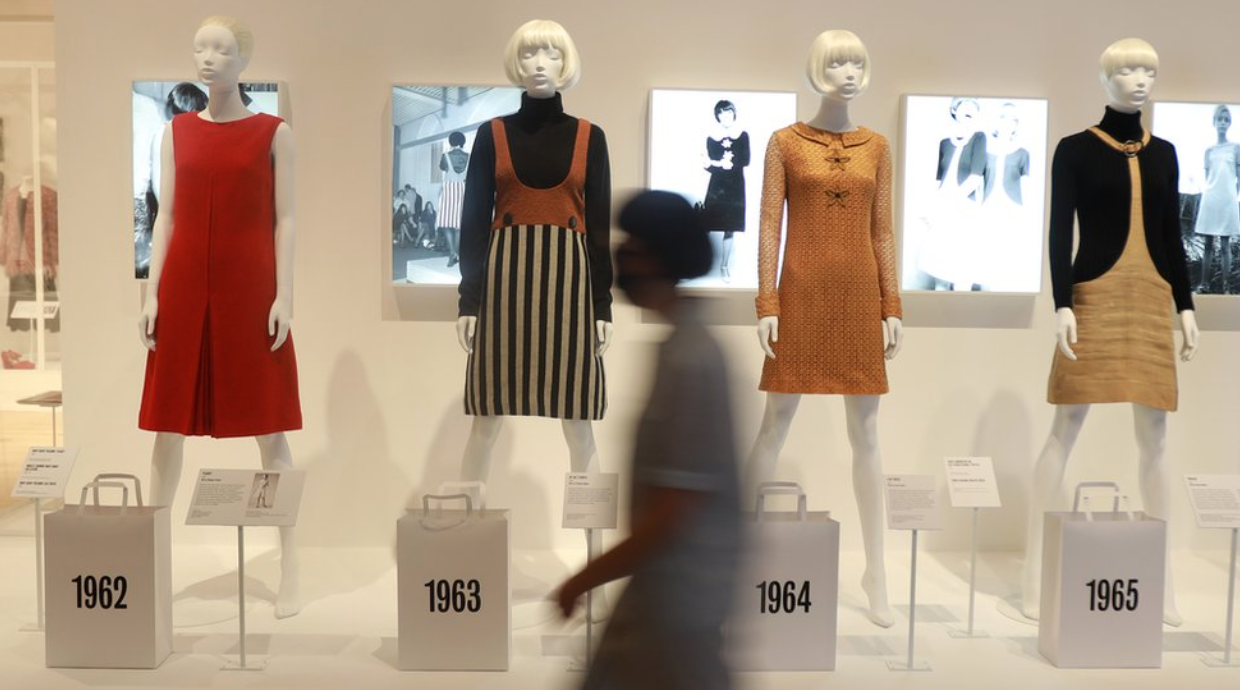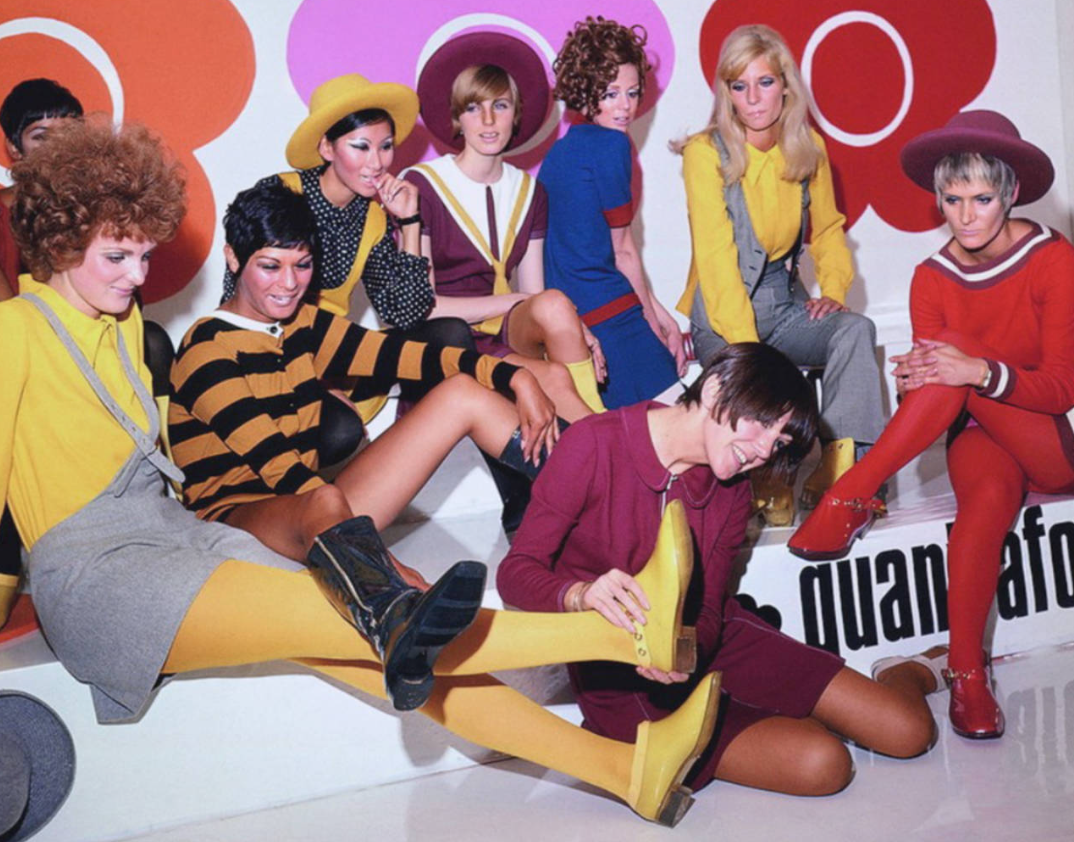Dame Mary Quant at the Kelvingrove Art Museum: Final Retrospective
By Ami Melville
Spring has finally arrived in Scotland. The bright yellow daffodil clusters that line fluffy green grass bloom under rejuvenated trees; cherry blossom petals are softly raining down in the April breeze. There’s a highly awaited peace in the air that comes with finishing classes and anticipating the days after exam season ends. Life feels so much more vivid, and it’s the perfect time to visit the last exhibition of Mary Quant’s international tour of her V&A retrospective at the Kelvingrove Art Gallery in Glasgow.
The Kelvingrove Art Gallery and Museum, courtesy of glasgowlife.org.uk.
Courtesy of Vogue.
Regarded as a pioneer of 1960s youth fashion movements, Dame Mary Quant’s distinctively Mod style and brightly colored clothes are timeless staples in women’s fashion history. Her designs vary in hemline, material, color and occasion, which signifies the growing need for individuality and change in the industry to reflect modern feminist thought. Quant is commonly credited with inventing the miniskirt, an iconic piece prominent in numerous clothing trends from the 70s to the current decade but was virtually unheard of in the first half of the 20th century. To Quant, the high hem of the miniskirt represented youth and modernity in a time of drastic societal change, from the attitudes regarding the role of women in the workforce and family to protesting sexism and domestic violence. Fashion was highly intertwined with the atmosphere of the times, and Quant successfully implemented these social developments into her pieces.
Courtesy of Michael McGurk, BBC.
She additionally emphasized the need for pockets in women’s garments, famously stating that the “pockets make the dress.” Quant understood the need for the coexistence of practicality and style, especially as more women entered the workforce and required their garments to have utilitarian features. She revolutionized workwear for women, canonizing trousers as essential in their wardrobes for convenience and sophistication. Trousers had been formerly regarded as exclusively men’s garments, and societal attitudes towards women wearing them were extremely unwelcoming.
However, when Quant displayed them along with dungarees and knickerbockers in her 1962 “Toms” trouser ensemble, they quickly became popular and well-worn among several generations of women. First worn by female travelers riding on horseback in the 1880s, this widestream recognition of trousers in women’s style was highly favored. She also styled cropped t-shirts in this collection, an unprecedented look in female fashion that remains a significant staple today in the wardrobes of countless young women.
Courtesy of the V&A. Left to right: 'Toms' trouser ensemble, Mary Quant. Photograph by John French, 1962 © Victoria and Albert Museum. Peggy Moffitt wearing 'Brands Hatch' dungarees, another model wearing 'Huntin' jacket and 'Humphrey' culottes, 1966. Image courtesy Mary Quant Archive / Victoria and Albert Museum, London.
Quant’s expressive combating of traditional gendering in clothing reflects the modern, youthful call for liberation in the female fashion industry. Introducing androgyny into women’s style allowed for women to explore their individual expression through clothing, and reexamine who they wanted to (and could) be through experimenting with a broader range of colors and silhouettes. She was fearless in her intent to liberate the strict societal standards that dictated what women could wear and when, and she effectively fought against such rules through designing clothes that were both unique and useful so that they could be worn during different occasions. Pants could be worn at work; soft trousers could be worn to sleep. Onesies could be styled as sleek outerwear for the warmer months; oversized sweaters were highly celebrated during the winter. Quant showed women that fashion is nonbinary, both in terms of gendered clothing pieces and the styles women could wear.
Courtesy of V&A: Mary Quant and models at the launch of the quantafoot collection, 1967. © PA Prints 2008.
Quant’s collection, organized by the Victoria and Albert Museum, will be exhibited at the Kelvingrove Art Gallery from May 20th to October 22nd. It will feature over 100 garments, accessories and iconic items from the V&A’s collection, as well as from many private archives. It will focus on the “Swinging Sixties” and Quant’s 1955 boutique Bazaar, which displayed many of her bold and colorful original designs. This will be the final touring exhibition of such an extensive collection of Quant’s work, and the perfect inspiration for summer wardrobe shopping.
Bibliography
“Mary Quant.” Glasgow Life. https://www.glasgowlife.org.uk/museums/venues/kelvingrove-art-gallery-and-museum/mary-quant-fashion-revolutionary.
“V&A · Six Revolutionary Designs by Mary Quant.” Victoria and Albert Museum. https://www.vam.ac.uk/articles/six-revolutionary-designs-by-mary-quant.
“Miniskirt Mayhem! Nine Ways Mary Quant Revolutionised Women's Clothes – and Lives.” The Guardian. Guardian News and Media, October 28, 2021. https://www.theguardian.com/fashion/2021/oct/28/miniskirt-mayhem-nine-ways-mary-quant-revolutionised-womens-clothes-and-lives.
Ogston, Graeme. “Iconic Designer Mary Quant Will Be 'Delighted' by V&A Dundee Show.” BBC News. BBC, August 26, 2020. https://www.bbc.co.uk/news/uk-scotland-tayside-central-53920837.





